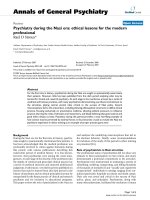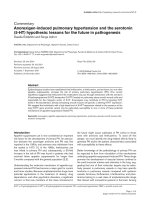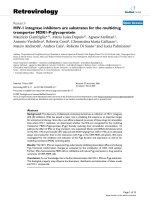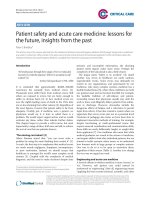Lessons for the you economist robert p murphy
Bạn đang xem bản rút gọn của tài liệu. Xem và tải ngay bản đầy đủ của tài liệu tại đây (4.94 MB, 414 trang )
Lessons for the Young
ECONOMIST
Lessons for the Young
ECONOMIST
ROBERT P. MURPHY
LvMI
Mises Institute
ISBN: 978-1-933550-88-6
Copyright © 2010 by the Ludwig von Mises Institute and published under the Creative
Commons Attribution License 3.0. />For information write the Ludwig von Mises Institute, 518 West Magnolia Avenue,
Auburn, Alabama 36832. Mises.org
Contents
Acknowledgments . . . . . . . . . . . . . . . . . . . . . . . . . . . . . . . . . . . . . . . . . . . . . . . . . . . . . . .
ix
PART I: FOUNDATIONS
1. Thinking Like an Economist . . . . . . . . . . . . . . . . . . . . . . . . . . . . . . . . . . . . . . . . . . . . 3
Thinking Like an Economist . . . . . . . . . . . . . . . . . . . . . . . . . . . . . . . . . . . . . . . . . . . . 3
Is Economics a Science? . . . . . . . . . . . . . . . . . . . . . . . . . . . . . . . . . . . . . . . . . . . . . . . . . 5
The Scope and Boundaries of Economic Science . . . . . . . . . . . . . . . . . . . . . . . . . . . 5
Why Study Economics? . . . . . . . . . . . . . . . . . . . . . . . . . . . . . . . . . . . . . . . . . . . . . . . . . 8
2. How We Develop Economic Principles . . . . . . . . . . . . . . . . . . . . . . . . . . . . . . . . 13
Purposeful Action versus Mindless Behavior . . . . . . . . . . . . . . . . . . . . . . . . . . . . 13
The Social versus the Natural Sciences . . . . . . . . . . . . . . . . . . . . . . . . . . . . . . . . . . 15
The Success of the Natural Sciences versus the Social Sciences . . . . . . . . . . . . 17
How We Develop Basic Economics . . . . . . . . . . . . . . . . . . . . . . . . . . . . . . . . . . . . . 22
3. Economic Concepts Implied By Action . . . . . . . . . . . . . . . . . . . . . . . . . . . . . . . . 31
Introduction . . . . . . . . . . . . . . . . . . . . . . . . . . . . . . . . . . . . . . . . . . . . . . . . . . . . . . . . . . 31
Only Individuals Act . . . . . . . . . . . . . . . . . . . . . . . . . . . . . . . . . . . . . . . . . . . . . . . . . . 32
Individuals Have Preferences . . . . . . . . . . . . . . . . . . . . . . . . . . . . . . . . . . . . . . . . . . 36
Preferences Are Subjective . . . . . . . . . . . . . . . . . . . . . . . . . . . . . . . . . . . . . . . . . . . . . 37
Preferences Are a Ranking, Not a Measurement Using Numbers . . . . . . . . . . 39
Different Individuals’ Preferences Can’t Be Combined . . . . . . . . . . . . . . . . . . . . 42
4. “Robinson Crusoe” Economics . . . . . . . . . . . . . . . . . . . . . . . . . . . . . . . . . . . . . . . . 49
Introduction . . . . . . . . . . . . . . . . . . . . . . . . . . . . . . . . . . . . . . . . . . . . . . . . . . . . . . . . . . 49
Crusoe Creates Goods With His Mind Powers . . . . . . . . . . . . . . . . . . . . . . . . . . . 50
Consumer Goods versus Producer Goods . . . . . . . . . . . . . . . . . . . . . . . . . . . . . . . 52
Land, Labor, and Capital Goods . . . . . . . . . . . . . . . . . . . . . . . . . . . . . . . . . . . . . . . . 53
Income, Saving, and Investment . . . . . . . . . . . . . . . . . . . . . . . . . . . . . . . . . . . . . . . . 55
Goods Are Valued Unit by Unit . . . . . . . . . . . . . . . . . . . . . . . . . . . . . . . . . . . . . . . . 59
Pulling It All Together: What Should Crusoe Do With Himself? . . . . . . . . . . . . 61
v
vi
|
Lessons for the Young Economist
PART II: CAPITALISM: THE MARKET ECONOMY
5. The Institution of Private Property . . . . . . . . . . . . . . . . . . . . . . . . . . . . . . . . . . 71
Society Requires Rules . . . . . . . . . . . . . . . . . . . . . . . . . . . . . . . . . . . . . . . . . . . . . . . . . 71
Capitalism: This Is Private Property . . . . . . . . . . . . . . . . . . . . . . . . . . . . . . . . . . . . 73
The Market Economy and Free Enterprise . . . . . . . . . . . . . . . . . . . . . . . . . . . . . . . 74
6. Direct Exchange and Barter Prices . . . . . . . . . . . . . . . . . . . . . . . . . . . . . . . . . . . 81
Why Do People Trade With Each Other? . . . . . . . . . . . . . . . . . . . . . . . . . . . . . . . . 81
Direct Exchange / Barter . . . . . . . . . . . . . . . . . . . . . . . . . . . . . . . . . . . . . . . . . . . . . . . 82
Prices . . . . . . . . . . . . . . . . . . . . . . . . . . . . . . . . . . . . . . . . . . . . . . . . . . . . . . . . . . . . . . . . 83
How Prices Are Formed in Barter . . . . . . . . . . . . . . . . . . . . . . . . . . . . . . . . . . . . . . . 84
7. Indirect Exchange and the Appearance of Money . . . . . . . . . . . . . . . . . . . . . 99
The Limitations of Direct Exchange . . . . . . . . . . . . . . . . . . . . . . . . . . . . . . . . . . . . . 99
The Advantages of Indirect Exchange . . . . . . . . . . . . . . . . . . . . . . . . . . . . . . . . . . 101
The Advantages of Money . . . . . . . . . . . . . . . . . . . . . . . . . . . . . . . . . . . . . . . . . . . . 104
Who Invented Money? . . . . . . . . . . . . . . . . . . . . . . . . . . . . . . . . . . . . . . . . . . . . . . . 106
8. The Division of Labor and Specialization . . . . . . . . . . . . . . . . . . . . . . . . . . . . 113
The Division of Labor and Specialization . . . . . . . . . . . . . . . . . . . . . . . . . . . . . . . 113
Why Specialization Makes Labor More Productive . . . . . . . . . . . . . . . . . . . . . . 115
Enriching Everyone By Focusing on Comparative Advantage . . . . . . . . . . . . 117
9. Entrepreneurship and Competition . . . . . . . . . . . . . . . . . . . . . . . . . . . . . . . . . . 125
Entrepreneurship . . . . . . . . . . . . . . . . . . . . . . . . . . . . . . . . . . . . . . . . . . . . . . . . . . . . 125
Competition Protects Customers . . . . . . . . . . . . . . . . . . . . . . . . . . . . . . . . . . . . . . 127
Competition Protects Workers . . . . . . . . . . . . . . . . . . . . . . . . . . . . . . . . . . . . . . . . . 128
10. Income, Saving, and Investment . . . . . . . . . . . . . . . . . . . . . . . . . . . . . . . . . . . 135
Income, Saving, and Investment . . . . . . . . . . . . . . . . . . . . . . . . . . . . . . . . . . . . . . . 135
Investment Increases Future Income . . . . . . . . . . . . . . . . . . . . . . . . . . . . . . . . . . . 136
How Saving and Investment Increase An Economy’s Future Output . . . . . . 141
11. Supply and Demand . . . . . . . . . . . . . . . . . . . . . . . . . . . . . . . . . . . . . . . . . . . . . . . . 147
Supply and Demand: The Purpose . . . . . . . . . . . . . . . . . . . . . . . . . . . . . . . . . . . . . 147
Demand: Its Definition and Its Law . . . . . . . . . . . . . . . . . . . . . . . . . . . . . . . . . . . . 148
Supply: Its Definition and Its Law . . . . . . . . . . . . . . . . . . . . . . . . . . . . . . . . . . . . . 153
Using Supply and Demand to Explain the Market Price . . . . . . . . . . . . . . . . . 155
Using Supply and Demand to Understand Price Changes . . . . . . . . . . . . . . . 159
Contents
12. Interest, Credit, and Debt . . . . . . . . . . . . . . . . . . . . . . . . . . . . . . . . . . . . . . . . . . 175
Interest: It’s About Time . . . . . . . . . . . . . . . . . . . . . . . . . . . . . . . . . . . . . . . . . . . . . . 175
Savings, Investment, and Economic Growth . . . . . . . . . . . . . . . . . . . . . . . . . . . . 177
Common Credit Transactions . . . . . . . . . . . . . . . . . . . . . . . . . . . . . . . . . . . . . . . . . 180
The Pros and Cons of Debt . . . . . . . . . . . . . . . . . . . . . . . . . . . . . . . . . . . . . . . . . . . . 183
13. Profit and Loss Accounting . . . . . . . . . . . . . . . . . . . . . . . . . . . . . . . . . . . . . . . . . 191
Profit and Loss Guide Entrepreneurs . . . . . . . . . . . . . . . . . . . . . . . . . . . . . . . . . . . 191
Interest Versus Profit . . . . . . . . . . . . . . . . . . . . . . . . . . . . . . . . . . . . . . . . . . . . . . . . . 193
The Social Function of Profit and Loss Accounting . . . . . . . . . . . . . . . . . . . . . . 195
The Limits of Profit and Loss Accounting . . . . . . . . . . . . . . . . . . . . . . . . . . . . . . . 199
14. The Stock Market . . . . . . . . . . . . . . . . . . . . . . . . . . . . . . . . . . . . . . . . . . . . . . . . . . . 205
The Stock Market . . . . . . . . . . . . . . . . . . . . . . . . . . . . . . . . . . . . . . . . . . . . . . . . . . . . 205
Why Issue Stock? (Debt versus Equity) . . . . . . . . . . . . . . . . . . . . . . . . . . . . . . . . . 206
The Social Function of Stock Speculation . . . . . . . . . . . . . . . . . . . . . . . . . . . . . . . 209
PART III: SOCIALISM: THE COMMAND ECONOMY
15. The Failures of Socialism—Theory . . . . . . . . . . . . . . . . . . . . . . . . . . . . . . . . . . 221
The Vision of Pure Socialism . . . . . . . . . . . . . . . . . . . . . . . . . . . . . . . . . . . . . . . . . . 221
Socialism’s Incentive Problem . . . . . . . . . . . . . . . . . . . . . . . . . . . . . . . . . . . . . . . . . 223
Socialism’s Calculation Problem . . . . . . . . . . . . . . . . . . . . . . . . . . . . . . . . . . . . . . . 229
16. The Failures of Socialism—History . . . . . . . . . . . . . . . . . . . . . . . . . . . . . . . . . . 239
Economic Theory and History . . . . . . . . . . . . . . . . . . . . . . . . . . . . . . . . . . . . . . . . . 239
Communism vs. Fascism . . . . . . . . . . . . . . . . . . . . . . . . . . . . . . . . . . . . . . . . . . . . . 241
Socialism’s Body Count . . . . . . . . . . . . . . . . . . . . . . . . . . . . . . . . . . . . . . . . . . . . . . . 242
PART IV: INTERVENTIONISM: THE MIXED ECONOMY
17. Price Controls . . . . . . . . . . . . . . . . . . . . . . . . . . . . . . . . . . . . . . . . . . . . . . . . . . . . . . 255
The Vision of Interventionism . . . . . . . . . . . . . . . . . . . . . . . . . . . . . . . . . . . . . . . . . 255
Price Ceilings . . . . . . . . . . . . . . . . . . . . . . . . . . . . . . . . . . . . . . . . . . . . . . . . . . . . . . . . 256
Price Floors . . . . . . . . . . . . . . . . . . . . . . . . . . . . . . . . . . . . . . . . . . . . . . . . . . . . . . . . . . 261
| vii
viii
|
Lessons for the Young Economist
18. Sales and Income Taxes . . . . . . . . . . . . . . . . . . . . . . . . . . . . . . . . . . . . . . . . . . . . 271
Government Spending . . . . . . . . . . . . . . . . . . . . . . . . . . . . . . . . . . . . . . . . . . . . . . . 271
How Government Finances Its Spending . . . . . . . . . . . . . . . . . . . . . . . . . . . . . . . 275
Sales Taxes . . . . . . . . . . . . . . . . . . . . . . . . . . . . . . . . . . . . . . . . . . . . . . . . . . . . . . . . . . 277
Income Taxes . . . . . . . . . . . . . . . . . . . . . . . . . . . . . . . . . . . . . . . . . . . . . . . . . . . . . . . . 279
19. Tariffs and Quotas . . . . . . . . . . . . . . . . . . . . . . . . . . . . . . . . . . . . . . . . . . . . . . . . . . 287
Mercantilism . . . . . . . . . . . . . . . . . . . . . . . . . . . . . . . . . . . . . . . . . . . . . . . . . . . . . . . . 287
The General Case for Free Trade . . . . . . . . . . . . . . . . . . . . . . . . . . . . . . . . . . . . . . . 289
Tariffs . . . . . . . . . . . . . . . . . . . . . . . . . . . . . . . . . . . . . . . . . . . . . . . . . . . . . . . . . . . . . . . 293
Import Quotas . . . . . . . . . . . . . . . . . . . . . . . . . . . . . . . . . . . . . . . . . . . . . . . . . . . . . . . 299
20. The Economics of Drug Prohibition . . . . . . . . . . . . . . . . . . . . . . . . . . . . . . . . 305
Drug Prohibition . . . . . . . . . . . . . . . . . . . . . . . . . . . . . . . . . . . . . . . . . . . . . . . . . . . . . 305
Drug Prohibition Corrupts Government Officials . . . . . . . . . . . . . . . . . . . . . . . 307
Drug Prohibition Fosters Violence . . . . . . . . . . . . . . . . . . . . . . . . . . . . . . . . . . . . . 314
Drug Prohibition Reduces Product Safety . . . . . . . . . . . . . . . . . . . . . . . . . . . . . . 320
Money Inflation vs. Price Inflation . . . . . . . . . . . . . . . . . . . . . . . . . . . . . . . . . . . . . 325
21. Inflation . . . . . . . . . . . . . . . . . . . . . . . . . . . . . . . . . . . . . . . . . . . . . . . . . . . . . . . . . . . . 325
How Governments Make Prices Rise . . . . . . . . . . . . . . . . . . . . . . . . . . . . . . . . . . . 329
The Danger of Government Price Inflation . . . . . . . . . . . . . . . . . . . . . . . . . . . . . 336
22. Government Debt . . . . . . . . . . . . . . . . . . . . . . . . . . . . . . . . . . . . . . . . . . . . . . . . . . 345
Government Deficits and Debt . . . . . . . . . . . . . . . . . . . . . . . . . . . . . . . . . . . . . . . . 345
Government Debt and Inflation . . . . . . . . . . . . . . . . . . . . . . . . . . . . . . . . . . . . . . . 350
Government Debt and Future Generations . . . . . . . . . . . . . . . . . . . . . . . . . . . . . 353
23. The Business Cycle . . . . . . . . . . . . . . . . . . . . . . . . . . . . . . . . . . . . . . . . . . . . . . . . . 361
The Business Cycle . . . . . . . . . . . . . . . . . . . . . . . . . . . . . . . . . . . . . . . . . . . . . . . . . . . 361
How Governments Cause the Business Cycle . . . . . . . . . . . . . . . . . . . . . . . . . . . 363
The Inevitable Bust Following an Artificial Boom . . . . . . . . . . . . . . . . . . . . . . . 368
The Causes of Mass Unemployment . . . . . . . . . . . . . . . . . . . . . . . . . . . . . . . . . . . 369
Glossary . . . . . . . . . . . . . . . . . . . . . . . . . . . . . . . . . . . . . . . . . . . . . . . . . . . . . . . . . . . . . . . 377
Acknowledgments
T
his book was launched in a meeting with Doug French and Jeff Tucker
of the Mises Institute. At every step in its writing, I consulted with
Zachariah Crossen, a history teacher who ran the sample chapters by
his own (junior high) students to make sure the tone and language were
correct.
Brian Shelley and Blake Stephenson provided useful feedback on an
early draft. Tim Terrell went through the entire manuscript and provided
many suggestions to improve it. Finally, I’d like to thank Sam Torode for
the artwork, which was not only done excellently but also quickly (because
I didn’t give him much notice).
ix
Part I
FOUNDATIONS
Lesson 1
Thinking Like an Economist
In this lesson you will learn:
• What it means to “think like an economist.”
• The types of questions that economics can help explain.
• Why it is important for everyone to understand basic economics.
Thinking Like an Economist
T
his book is a manual for a new way of looking at the world. After you
master the lessons contained within these pages, you will be able to
understand events in ways that your untrained peers will miss. You
will notice patterns that they will overlook. The ability to think like an
economist is a crucial component of your education. Only with sound economic thinking will you be able to make sense of how the world works. To
make responsible decisions regarding grand political ideas as well as your
occupation and mundane household finances, you must first decide to learn
basic economics.
Creative and careful thinkers throughout human history have developed various disciplines for studying the world. Each discipline (or subject) offers its own perspective as history unfolds before us. For a complete
education, the student must become acquainted with some of the most
3
4
|
Lessons for the Young Economist
important findings in each field. Economics has proven itself to be worthy
of universal study. A well-rounded young adult will have studied not only
algebra, Dante, and photosynthesis, but will also be able to explain why
prices rise.
Every subject you study will contain a mixture of knowledge that is
deemed important for its own sake, as well as practical applications that
may prove useful in your daily life. For example, every student should
have a basic understanding of astronomy, since it illustrates the grandeur
of the universe; but basic astronomy can also come in handy when guiding
a wayward yachtsman who has lost sight of land. For a different example,
consider mathematics. The study of advanced calculus is rewarding for its
sheer elegance (though some students might consider the reward inadequate for the effort required!). But everyone needs to know basic arithmetic
in order to function in society.
We will see the same pattern holds in the subject of economics. It is,
in a word, simply fascinating to learn that there are underlying principles
or “laws” that explain the operation of any economy, whether in ancient
Rome, the Soviet Union, or a county fair in Boise, Idaho. Yet economics also
has much to offer in practical guidance of your daily life. Knowledge of
economics, by itself, will not make you rich, but it’s a good bet that ignoring
the lessons of this book will keep you poor.
Economists look at the world in a unique way. Picture the crowds waiting to ride a popular amusement park roller coaster. A biologist surveying
the scene might notice that people begin sweating as they approach their
turn to get onto the ride. A physicist might notice that the first hill has to be
the tallest. A sociologist might notice that the riders are arranged in groups
of the same ethnicity. And an economist might notice that the first and last
cars have much longer lines than the others, probably because people don’t
like waiting but they also prefer riding in the very front or the very rear.
The economic perspective is not useful in every situation. On the soccer
field or at the prom, the lessons in this book will not prove as relevant. But
in your life you will encounter many situations of critical importance when
your decisions will need to be informed by sound economics. It is not necessary for everyone to become an economist. It is important for everyone to
learn how to think like an economist.
Lesson 1: Thinking Like an Economist
| 5
Is Economics a Science?
In this book, we adopt the view that economics constitutes an independent science, just as surely as chemistry and biology are distinct fields of
study. As we go through the lessons in this book, we will do so scientifically,
meaning that we will use an objective set of “tools” for our analysis, that
do not rely on particular ethical or cultural assumptions. The principles or
laws of economics are the same, whether the economist is a Republican or a
communist, and whether he lives in New Zealand or Somalia.
Warning! When we say economics is a science, we do not mean that we
conduct experiments to test economic laws, the way a nuclear physicist
studies the results of smashing atoms in a particle accelerator. There are
important differences between a social science such as economics, versus a
natural science such as physics. We will explain this in more detail in Lesson
2, but for now we simply want to caution you that basic economic principles can be discovered through mental reasoning. It wouldn’t make sense
to go out and “test” the laws of economics, just as it doesn’t make sense to
use a ruler to go out and “test” the various proofs that you might learn in
a geometry class. The upshot of all this is that the lessons in this book will
stand the test of time—there is no danger that a new experimental finding
will overturn them tomorrow. In practice, professional economists make
all sorts of conjectures, many of which turn out to be wrong. But the core
body of economic theory—the types of laws and concepts contained in this
book—is not testable; it’s simply a way of viewing the world.
Despite the possible confusion of economic science with a natural science, nonetheless we use the term science because it’s important to stress
that there really are objective laws of economics. When politicians ignore
the teachings of economics, their programs run into disaster—imagine the
chaos if NASA ignored the laws of physics!
The Scope and Boundaries of Economic Science
It’s a common misconception for people to think, “Economics is the
study of money.” Yes, economics obviously has a lot to say about money,
and in fact one of the basic purposes of economics is to explain the different
6
|
Lessons for the Young Economist
prices—which are quoted in units of money—of various goods and services being sold in the market place.
Contrary to this popular misconception, economics is broader than the
mere study of money. In its widest scope, economics can be defined as the
study of exchanges. This would include all of the exchanges in a normal market setting, where the seller hands over a physical object or provides a service, and in return the buyer hands over the appropriate amount of money.
But economics also studies cases of barter, where the traders exchange
goods or services directly with each other, without using money at all.
Pushing it to the extreme, economics even has a lot to say about cases
where a single, isolated person takes actions to improve his or her situation.
This is often called “Crusoe economics,” after the fictional character Robinson Crusoe who was shipwrecked on an (apparently) deserted island.
We will study Crusoe economics in Lesson 4. It will be clear that even an
isolated person behaves “economically” because he takes what nature has
given him and exchanges the status quo for an environment that he hopes
will be more pleasant.
The common theme running throughout all of the examples of exchanges
is the concept of scarcity. Scarcity can be succinctly explained by the
observation that there are limited resources and unlimited desires. Even
Bill Gates faces tradeoffs; he cannot literally do whatever he wants. If he
takes his wife out to a fancy restaurant, he has reduced his options (ever so
slightly) and has diminished his ability to buy other things in the future.
We can describe the situation by saying, “Bill Gates needs to economize on
his resources, because they are finite.”
It is the universal fact of scarcity that gives rise to what people have
termed the “economic problem”: As a society, how should we decide which
goods and services to produce, with the limited resources at our disposal?
In Lesson 5, we will see how the institution of private property solves this
problem. But it is scarcity that causes the problem in the first place.
Warning! Economics does not study a hypothetical “economic man,”
who cares only about acquiring material possessions or earning money.
This is another common misunderstanding of what economics is all about.
Unfortunately, there is some truth to this stereotype because many economists actually do build models of the economy that are filled with fictitious
people who are very selfish and will only act altruistically if they are forced
Lesson 1: Thinking Like an Economist
to do so. But in this book, you will not be learning any theories of that flavor. Instead, the lessons in this book do not depend on people being pennypinchers; the laws we will develop in these pages apply to Mother Teresa as
much as they apply to Donald Trump.
Economic science, as taught in this book, does not tell workers that they
should take whatever job pays the most money, nor does it tell business
owners that they must consider only financial issues when running their
operations. These points will be made clearer during the subsequent lessons themselves, but we must stress up front that there is no “economic
man” in the following pages; we are always discussing the principles that
explain the choices of real people in the face of scarcity. The principles
involve the fact that people have desires in the face of limited resources, but
the principles are broad enough to cover people with any desires.
The Economics of Real People
Economics deals with the real actions of real men. Its [laws] refer neither
to ideal nor to perfect men, neither to the phantom of a fabulous economic man (homo oeconomicus) nor to the statistical notion of an average
man. . . . Man with all his weaknesses and limitations, every man as he lives
and acts, is the subject matter of [economics].
—Ludwig von Mises, Human Action
(Auburn, Ala.: Ludwig von Mises Institute, 1998), pp. 646–47
Economics studies and tries to explain how people make exchanges. A
shipwrecked sailor wants to “exchange” some sticks and two rocks for a
crackling fire, while a missionary wants to “exchange” his leisure time for
a grueling trip to a remote jungle where the residents have never seen a
Bible. A complete theory of exchanges must cover these types of cases too,
not just the more familiar example of a broker exchanging 100 stock shares
for $2,000.
| 7
8
|
Lessons for the Young Economist
Why Study Economics?
One reason to study economics is that it’s simply interesting. When
you stop and think about what happens every day in a modern economy, it should take your breath away. Consider the bustling metropolis
of Manhattan: Millions of people work on this tiny island that is less than
23 square miles in land area. Obviously there is not enough food produced
on the island itself, to feed these hordes. At first some readers may not
understand this claim—some of the finest restaurants in the world are in
Manhattan! But these exquisite restaurants rely on vendors to give them
the raw materials to produce their very expensive dishes. If invading Martians placed an impenetrable plastic bubble around Manhattan (with small
holes in the plastic to allow for ventilation), within two months hundreds
of thousands of New Yorkers would be dead from starvation.
Yet in the real world—where no Martian bubble obstructs trade—farm
produce, refined gasoline, and other items are shipped into Manhattan on a
daily basis, allowing the inhabitants to not only eke out a bare survival, but
actually to thrive. The workers on the tiny island of Manhattan transform
the materials at their disposal into some of the most highly valued goods
and services on the planet—think of the expensive jewelry, clothing, financial services, legal work, and Broadway performances “produced” in Manhattan. When you consider the incredible complexity of these processes,
it is a wonder that its operation is normally so flawless that we take it for
granted. The lessons in this book will shed some light on how the market
economy achieves such feats, day in and day out.
Another reason to study economics is that it will help you make decisions
in your personal and professional life. Of course, the lessons in this book
will not by themselves make you rich. Rather, they will give you a framework to help analyze your plans so that you are more likely to achieve your
objectives. For an analogy, studying geometry alone will not allow you to
become a professional engineer, designing four-lane bridges. But nobody
would want to drive on a bridge designed by someone who is ignorant of
geometry.
Beyond its intrinsic beauty and practical applications to your own life,
economics is a crucial topic because we live in a society plagued by an
activist government. Unlike other scientific disciplines, the basic truths
Lesson 1: Thinking Like an Economist
of economics must be taught to enough people in order to preserve society itself. It really doesn’t matter if the man on the street thinks quantum
mechanics is a hoax; the physicists can go on with their research without
the approval of the average Joe. But if most people believe that minimum
wage laws help the poor, or that low interest rates cure a recession, then the
trained economists are helpless to avert the damage that these policies will
inflict on society.
For this reason, it is the young adult’s duty to learn basic economics. The
lessons in this book will show you how.
| 9









